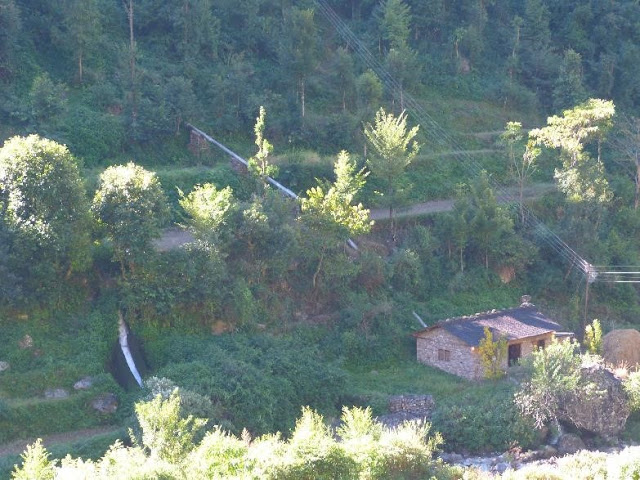 |
| Rolling hills of Baglung District |
Despite massive potential to generate electricity through large scale hydropower, Nepal often faces power cuts and the national grid only reaches around 65% of the population. Much of the non-grid connected population live in rural, hilly and mountainous areas where grid extension is difficult and costly. Micro-hydropower plants (MHPs), which deliver up to 100kW of electrical power, extract water from rivers and use it to drive a generator before returning the water to the same river further downstream. These systems can provide electricity for lighting and productive end uses that can vastly improve people’s quality of life. Since the 1970s, micro-hydro turbines have been manufactured in Nepal. Now there are around 2,500 MHPs installed across Nepal.
When these systems break or run poorly it has an adverse effect on the quality of people’s lives. Through my research, I am hoping to find methods to improve the reliability and sustainability of MHPs in Nepal. The aim of this project was to see how well systems were maintained and interview the people who run, manage and rely on hydropower plants. I hoped that interviews would help me to understand some of the technical and social challenges that MHPs face. Whilst in Nepal, I was working with a Nepali NGO called the People, Energy and Environment Development Association (PEEDA) who helped me to identify sites, arrange visits and conduct interviews.
 |
| A micro-hydropower plant |
During my time in Nepal, Prem Karki (from PEEDA) and I visited a total of 17 sites in the neighbouring districts of Baglung and Gulmi. Prem and I spent 12 days in the field, making our way from one site to the next via bumpy jeep rides and on foot. Nepal’s hills make it suitable for hydropower but also make travelling complicated. Many of the roads we travelled on were unpaved and we saw lots of places where landslides had damaged roads during the monsoon. This showed us how difficult it is to move equipment and materials when plants are under construction. At each site, our visual assessment took us on some nerve jangling walks along canals that snaked around cliff edges to reach the intakes. Prem was responsible for interviewing the plant operator, management representative and consumer at each site so we could understand how plants were maintained, managed and their importance to beneficiaries. The local people were very helpful and interested by our work. We were often given free meals and sometimes even a place to stay!
 |
| A winding canal |
I was able to collect a large amount of information which I am still processing digitally and mentally! In general, I found that micro-hydro sites are often impressive feats of engineering which can make a big impact on people’s lives by powering homes, businesses and services. In challenging environments where the only means of transportation is manpower, the hard work of local people has led to their construction. Several times, we crawled through hand chiselled caves made solely for a hydro project’s canal. The impact of the projects was clear to see. Every interview respondent said that connection to an MHP had made their life easier.
Furthermore, the micro-hydro projects are invaluable to communities as a whole; they power workplaces, shops, health posts and mobile phone masts. In the town of Burtibang, with a population of around 10,000, every home and business is powered by electricity from micro-hydro projects.
This dependence on micro-hydropower makes its reliability very important. I found the quality of maintenance very variable. Some sites were well cared for with an evident daily effort to keep the plant running as best as possible. Other plants had little evidence of regular maintenance and were showing signs of deterioration. Promisingly, I found that sites with formally trained operators tended to be better maintained than those without.
In terms of sustainability, there was a good standard of management. Energy meters allowed accurate measurement of electricity consumption so that consumers were charged according to their use. Consumers are typically given a short window in which to pay and fined for late payment. At most sites, managers said that there was sufficient money collected for the operation of the plant and maintenance costs.
 |
| A micro-hydropower turbine |
This blog is written by Cabot Institute member Joe Butchers, a PhD student from the Electrical Energy Management Group at the University of Bristol.
 |
| Joe Butchers |
